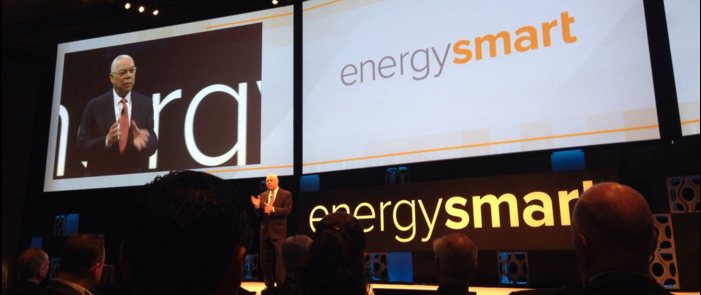This post is one in a series of feature stories on trends shaping advanced energy markets in the U.S. and around the world, drawn from Advanced Energy Now 2016 Market Report, which was prepared for AEE by Navigant Research.

Colin Powell speaks at this week's EnergySmart conference in Washington, D.C.
The amount of demand response (DR) capability in North America has grown considerably in the past five years, both at utilities and in competitive markets such as the PJM Interconnection (PJM) in the U.S. Northeast. Traditionally, however, DR has generally been relegated to a role as a last-called resource, deployed only at times of maximum stress on the grid. But not for long. We are embarking on a new era of DR, led by companies like EnerNOC.
The use of DR in grid planning and operations has solidified as utilities increasingly rely on DR to meet installed capacity requirements and sometimes even operating reserve requirements. Furthermore, independent system operators led by PJM have incorporated DR into procurement mechanisms for capacity, energy, and ancillary services. Industry acceptance of DR as an integral part of the future grid continues to grow, with states like California and New York rolling out major regulatory initiatives that enable a larger role for DR.
Hawaiian Electric (HECO), an investor-owned utility, has issued a request for proposals to DR aggregators for the provision of grid services, including ancillary services, from demand-side resources. As with other regulatory initiatives in the island state, Hawaii’s innovative uses for DR to help manage the grid in real time come in response to massive customer investment in behind-the-meter solar PV. This could be the future for many utilities that are only now seeing the first effects of customer investment in on-site renewables, storage, and other distributed energy resources.
DR is also expanding from big commercial electric customers to residences. Opower recently announced results from its behavioral DR (BDR) program. The company reported that it sent over 12 million personalized com- munications to customers during 29 DR events last summer, delivering 3% average peak reduction and over 5% savings under peak time rebate pricing plans. Utilities involved included Baltimore Gas and Electric (BGE), ComEd, DTE Energy, Consumers Energy, Pacific Gas and Electric (PG&E), and Hydro Ottawa. BGE is able to bid its BDR resource into PJM’s capacity market to meet system reliability needs.
Even as its value to customers and grid operators was growing, DR has until recently had its fate in the hands of the courts. Power generators sued FERC over its Order 745, on DR compensation in the wholesale energy markets like PJM’s, and the U.S. Court of Appeals for the D.C. Circuit ruled that the Order was an interference in retail electricity markets, over which state regulators have jurisdiction. But on January 25, the Supreme Court reversed the DC Circuit’s decision on both parts of the case, meaning that DR does fall under FERC’s jurisdiction, and the payment of full Locational Marginal Price (LMP) in the wholesale energy markets is just and reason- able. It was a full victory for DR providers like EnerNOC, Comverge, and Johnson Controls, and generators will have to learn to live with competition from real-time demand reduction.
The global market for DR services surpassed $2 billion in 2015, up 17% from 2014, with the United States representing two-thirds of that total.
Indeed, utilities will be entering a new era as DR technology further blurs the line between generation and demand-side resources, and not just in Hawaii. Looking ahead, emerging state policies and evolving market rules could drive DR to heights that would have been difficult to envision just five years ago.
Learn more about DR and all the other technologies that make up the advanced energy industry in Advanced Energy Now 2016 Market Report, available for free at the link below.
